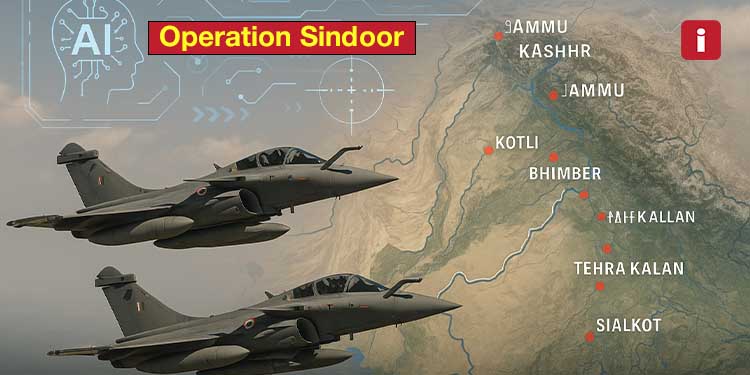India Deploys AI-Driven Warfare in “Operation Sindoor” Against Cross-Border Terrorism
In a bold technological and strategic move, the Indian Armed Forces launched Operation Sindoor in the early hours of May 6, 2025. This AI-assisted precision strike targeted nine high-value terror infrastructure sites across Pakistan and Pakistan-administered Kashmir, in response to the April 22 Pahalgam attack that killed 26 Indian civilians.
This marks one of India’s most technologically advanced military operations to date, showcasing a mix of satellite surveillance, AI-based target recognition, and next-gen weaponry—all coordinated under a real-time central command system.
What We Know So Far
According to official sources from the Indian Ministry of Defence, the operation lasted 23 minutes and involved Rafale fighter jets armed with SCALP cruise missiles and AASM Hammer smart bombs. These advanced weapons systems were deployed using real-time intelligence fused from AI-powered reconnaissance drones and satellite imaging.
Targeted Locations:
- Bahawalpur
- Muridke
- Tehra Kalan
- Sialkot
- Bhimber
- Kotli
- Muzaffarabad
Each of these locations has been identified as hubs for groups like Jaish-e-Mohammed, Lashkar-e-Taiba, and Hizbul Mujahideen.
AI-Powered Precision
A key element of Operation Sindoor was its use of artificial intelligence in defense targeting and coordination. Indian defense tech firms, in collaboration with DRDO and private AI startups, provided automated threat detection algorithms and live-strike simulations that reduced human error and optimized timing.
A senior IAF official stated:
“We leveraged AI to process satellite and drone feeds in real-time, helping us avoid collateral damage and minimize civilian exposure. Our mission was surgical and non-escalatory.”
India intentionally avoided military and civilian infrastructure on the Pakistani side, making the operation both strategic and ethical.
Government Briefing and Civilian Impact
A joint press briefing was held by Wing Commander Vyomika Singh, Colonel Sophia Qureshi, and Foreign Secretary Vikram Misri. They reaffirmed India’s right to self-defense and clarified that the action was “limited, measured, and intended to disrupt imminent threats.”
While civil aviation was temporarily suspended in parts of Jammu & Kashmir, no Indian aircraft was reported lost. However, Pakistan claimed civilian casualties and labeled the strike as an act of war—a claim that India categorically rejected.
Global and Diplomatic Response
The global reaction was swift but cautious. The United States, European Union, and United Nations called for restraint. However, Indian diplomatic circles emphasized that Operation Sindoor was defensive, not escalatory, and urged Pakistan to dismantle terrorist infrastructure operating with impunity inside its territory.
Tech Takeaway: The Future of Indian Military Ops
Operation Sindoor signals a new era for India’s armed forces, combining AI, machine learning, geospatial intelligence, and autonomous reconnaissance to conduct highly precise, low-risk operations.
Defense analysts suggest that this is only the beginning of AI-led combat doctrines in South Asia. India is reportedly scaling up its “Combat Cloud” system, allowing interoperability between army, navy, air force, and space assets.
Conclusion
Operation Sindoor is not just a retaliatory strike; it is a showcase of India’s evolving tech-military capability. The precision, speed, and intelligence-driven execution reflect how modern warfare is being redefined by artificial intelligence and next-generation defense systems.
As tensions simmer, India’s message is clear: technological superiority will be at the heart of its national security strategy going forward.













































